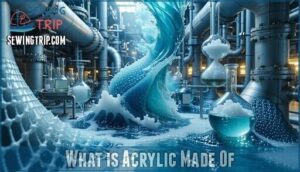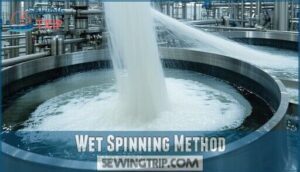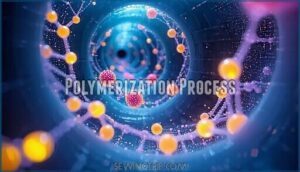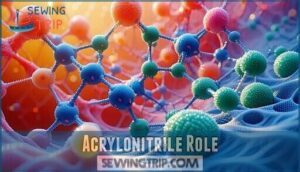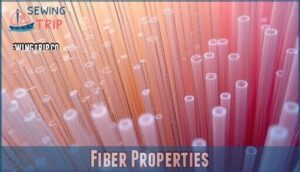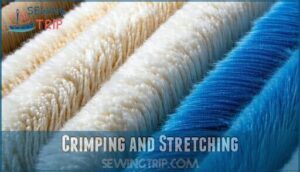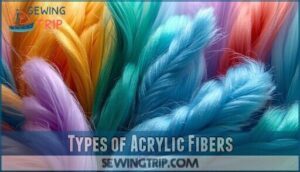This site is supported by our readers. We may earn a commission, at no cost to you, if you purchase through links.

You’ll find it starts as acrylonitrile monomers that undergo polymerization, creating long polymer chains.
These chains get spun through tiny holes called spinnerets, forming the soft fibers you know.
The process gives manufacturers precise control over the fabric’s properties, resulting in a material that’s naturally water-resistant, flame-retardant, and incredibly durable.
It mimics wool’s warmth while staying lightweight and easy to care for.
The synthetic nature means it won’t shrink or felt like natural fibers, making it perfect for everything from cozy sweaters to outdoor gear.
Understanding this manufacturing process reveals why acrylic performs so differently from natural alternatives, with benefits like being incredibly durable and having a synthetic nature that provides specific advantages, including being lightweight and easy to care for.
Table Of Contents
Key Takeaways
- You’re dealing with petroleum-based chemistry – Acrylic fabric starts as acrylonitrile monomers derived from fossil fuels like propylene and ammonia, which undergo polymerization to create polyacrylonitrile polymer chains containing at least 85% acrylonitrile content.
- The manufacturing process determines your fabric’s feel – Raw polymers get dissolved and extruded through tiny spinnerets using wet or dry spinning methods, then crimped and stretched to create the soft, wool-like texture you experience in finished garments.
- You get synthetic advantages over natural fibers – Acrylic’s molecular structure gives you water resistance, flame retardancy, lightweight warmth, and excellent color retention without the shrinking, felting, or high maintenance requirements of wool.
- You’re choosing between performance and environmental impact – While acrylic offers durability and affordability, it’s non-biodegradable, energy-intensive to produce (generating 21-54kg CO2 per kilogram), and contributes to microplastic pollution with limited recycling options.
Acrylic Fabric Composition
You’ll find that acrylic fabric consists primarily of polyacrylonitrile, a synthetic polymer created from petrochemical sources like propylene and ammonia.
This man-made material must contain at least 85% acrylonitrile monomer to qualify as true acrylic fabric, with the remaining portion made up of copolymers that enhance specific properties.
Polyacrylonitrile Polymer
Polyacrylonitrile serves as acrylic fabric’s backbone, forming through polymer synthesis where acrylonitrile molecules link together.
This molecular structure creates the chemical composition that gives acrylic fibers their unique properties.
Key characteristics of polyacrylonitrile include:
- Strong molecular bonds that resist degradation mechanisms
- Flexible polymer chains enabling diverse industrial applications
- Stable chemical structure maintaining polymer fabric durability
- Consistent molecular weight ensuring reliable acrylic fiber performance
This polymer foundation determines how your acrylic garments feel, perform, and last over time.
Petrochemical Derivatives
Understanding acrylic’s origins begins with fossil fuel-based fiber production.
Petrochemical refineries transform crude oil into essential building blocks like ethylene sources and propylene feedstock.
These polymer chemistry foundations combine with ammonia synthesis to create acrylonitrile through complex chemical reactions.
Coal derivatives also contribute to this fossilfuelbased fiber’s chemical composition, generating various polymer byproducts during manufacturing.
Acrylonitrile Monomer
At the heart of acrylic fabric lies acrylonitrile, a vital monomer that forms the backbone of polymer chemistry in textile manufacturing.
Through acrylonitrile synthesis and radical polymerization, these monomers transform into durable acrylic fabric.
The acrylonitrile derivatives and raw materials undergo precise polymerization chemistry, creating strong polymer chains.
Acrylic is also known for its resistance to pilling, which is a key factor in its performance.
Understanding monomer properties helps explain why acrylic performs so well in various applications.
What is Acrylic Made Of
At its core, acrylic fabric springs from a fossilfuelbased fiber made primarily of synthetic materials.
Acrylic fabric starts life as a synthetic fiber born from fossil fuels, giving it strength and versatility.
You’ll find that acrylonitrile serves as the main building block, comprising at least 85% of standard acrylic fibers.
This chemical compound comes from Raw Materials like propylene, ammonia, and air through Chemical Synthesis processes.
The Polymer Structure forms when manufacturers combine acrylonitrile with other monomers such as vinyl acetate or methyl acrylate.
This creates polyacrylonitrile, a long-chain polymer with approximately 1,900 monomer units and a molecular weight around 100,000.
Different Acrylic Variants emerge based on acrylonitrile content.
Modacrylic fibers contain 35-85% acrylonitrile, offering enhanced flame resistance.
Standard synthetic fabric requires higher concentrations for classification as true acrylic.
Production Scale operations transform these petrochemical derivatives into the versatile acrylic fabric you recognize today through controlled polymerization and fiber formation processes.
Production Process Overview
Understanding how acrylic fabric comes to life requires knowing its three main production methods.
You’ll discover how manufacturers transform raw petrochemicals into the soft, warm fibers found in your favorite sweaters and blankets.
Wet Spinning Method
In wet spinning, you dissolve polyacrylonitrile polymer in a solvent to create a spinning solution.
This method uses a coagulation bath where chemical usage helps transform the dissolved polymer into solid acrylic fibers through fiber formation.
The wet spinning process involves these key steps:
- Solution preparation – Mix polyacrylonitrile with solvents like dimethylformamide
- Extrusion – Push the solution through spinnerets into the coagulation bath
- Solidification – Fibers form as solvents get extracted by the chemical bath
- Collection – Gather the newly formed synthetic fabric fibers for further processing
While process efficiency is lower than dry spinning, wet spinning allows better control over fiber properties.
To enhance the final product, consider chemical softening options.
However, waste disposal becomes more complex due to solvent recovery requirements in acrylic fabric production.
Dry Spinning Method
In dry spinning, manufacturers dissolve synthetic polymers in a solvent, then extrude the solution through spinnerets into heated gas chambers.
Solvent evaporation occurs rapidly, forming solid acrylonitrile fibers without chemical baths.
This method offers superior energy efficiency and production speed compared to wet spinning, while creating enhanced fiber porosity.
The streamlined process makes acrylic fabric manufacturing more cost-effective and environmentally friendly.
Polymerization Process
Polymerization transforms raw acrylonitrile monomers into the synthetic polymers that become acrylic fabric.
You’ll find this chemical reaction combines acrylonitrile with other monomers through initiation methods that control chain formation.
The reaction kinetics determine molecular weight and polymer structure, creating the foundation for your favorite synthetic textiles.
- Chain reactions build strength – Each polymer chain contains approximately 1,900 monomer units
- Controlled termination creates consistency – Precise timing guarantees uniform molecular weight distribution
- Chemical bonds form durability – Strong polymer structures resist wear and maintain fabric integrity
Acrylonitrile Role
You’ll find that acrylonitrile is the main building block in acrylic fabric, making up at least 85% of its structure.
This chemical gives the fibers their strength, durability, and ability to hold vibrant colors, which is why acrylic fabric performs so well in everyday use.
Chemical Structure
Understanding acrylonitrile’s chemical structure reveals how this synthetic polymer creates durable fabric.
The monomer arrangement features a nitrile group (-CN) bonded to a vinyl backbone, forming long polymer chains through free radical polymerization.
These molecular bonds create strong structural isomers, while copolymer variations with vinyl acetate enhance flexibility and performance in the final textile product.
Synthetic fibers generally have higher tensile strength due to their molecular structure.
Molecular Weight
Polyacrylonitrile’s molecular weight directly affects your acrylic fabric’s performance characteristics.
The polymer reaches approximately 100,000 molecular weight units, creating these material properties:
- Polymer Chain Length determines fiber strength and durability
- Molecular Distribution influences fabric uniformity and texture
- Weight Influence affects processing temperature requirements
- Viscosity Correlation impacts spinning efficiency during manufacturing
This molecular structure creates the synthetic fabric’s distinctive feel and performance.
Monomer Units
Within the polyacrylonitrile polymer structure, you’ll find approximately 1,900 individual monomer units linked together through polymerization.
These acrylonitrile monomers create long polymer chains with specific molecular arrangements that determine acrylic fabric’s properties.
The acrylonitrile percentage must reach at least 85% for true acrylic classification, while various copolymer types can comprise the remaining percentage, affecting the final material characteristics.
Fiber Properties
Once you understand acrylic’s basic composition, you’ll want to know how these synthetic fibers actually perform in real-world applications.
The unique properties of polyacrylonitrile give acrylic fabric its distinctive characteristics that make it both popular and controversial among textile users.
Warmth and Softness
You’ll find acrylic fabric delivers exceptional warmth through its unique fiber structure that traps air like natural wool.
The synthetic material creates cozy sweaters with remarkable softness that rivals traditional Wool Comparison options.
Comfort Factors include excellent Insulation Value while maintaining breathable properties.
Tactile Qualities of acrylic yarn feel pleasant against your skin, making it ideal for garments requiring both comfort and thermal efficiency in cold weather applications, providing excellent Insulation Value and thermal efficiency.
Lightweight Nature
Acrylic fabric’s feather-light construction makes it perfect for comfortable layering without adding bulk to your wardrobe.
Layer up with acrylic’s feather-light warmth – all the coziness, none of the bulk.
This synthetic textile weighs substantially less than wool while maintaining excellent warmth retention.
Here are three key Layering Benefits of lightweight acrylic fabric:
- Seasonal Use versatility – You can wear multiple layers in winter without feeling weighed down
- Comfort Factor enhancement – The reduced weight prevents fatigue during extended wear
- Blending Options flexibility – Combines easily with other synthetic fibers for ideal Weaving Applications
Hydrophobic Properties
Water repels right off acrylic fabric’s surface thanks to its hydrophobic nature.
This fossil-fuel-based fiber naturally resists moisture, creating excellent stain resistance and quick drying properties.
However, synthetic textiles like acrylic generate static buildup, which can cause clinging.
Despite limited moisture wicking compared to natural fibers, acrylic fabric maintains its lightweight feel.
| Property | Acrylic Performance | Impact |
|---|---|---|
| Water Repellency | Excellent | Stays dry longer |
| Stain Resistance | High | Easy maintenance |
| Quick Drying | Very Fast | Convenient washing |
| Static Buildup | High | Clings to skin |
| Moisture Wicking | Limited | Poor breathability |
Manufacturing Steps
Once you understand acrylic’s composition, you’ll want to see how raw materials transform into finished fabric through specific manufacturing steps.
The journey from polymer solution to soft, durable textile involves three critical phases that determine the final product’s quality and characteristics.
Extrusion Process
During the manufacturing process, you’ll witness polymer solution being forced through a spinneret design at controlled extrusion speed.
The synthetic polymer transforms from viscous liquid into continuous filaments through precisely engineered holes.
Fiber diameter depends on spinneret openings and polymer viscosity.
This critical step shapes acrylonitrile into synthetic fibers before filament coagulation begins, determining the acrylic fabric’s final characteristics.
Crimping and Stretching
Once crimped fibers pass through specialized rollers, stretching aligns polymer chains and enhances fiber strength.
This Crimping Purpose creates texture while Stretching Effects improve durability.
The process transforms straight synthetic textiles into stretchy, wool-like acrylic fabric with enhanced Fiber Alignment for superior Yarn Formation.
- Crimping Purpose – Adds natural texture and bulk to synthetic fibers
- Texture Enhancement – Creates wool-like feel and appearance in acrylic fabric
- Fiber Alignment – Stretching orients polymer chains for increased strength
- Yarn Formation – Prepared crimped fibers ready for spinning into usable yarn
Washing and Drying
Once crimped fibers complete their texture formation, thorough washing removes residual chemicals and solvents from production.
You’ll notice manufacturers use precise washing temperatures and controlled drying methods to prevent shrinkage concerns while maintaining fiber integrity.
Proper washing machine settings and detergent selection during this stage help establish pilling prevention characteristics and reduce static buildup that affects the final fabric’s performance and care label specifications.
Types of Acrylic Fibers
You’ll find acrylic fibers come in several distinct types, each engineered for specific performance characteristics and applications.
Understanding these variations helps you choose the right acrylic material for your intended use, whether you need enhanced flame resistance or specialized textile properties.
Modacrylic Fibers
You’ll find modacrylic fibers contain 35-85% acrylonitrile, compared to standard acrylic fabric’s 85% minimum.
This reduced fiber content creates enhanced flame retardancy and durability enhancement through modified chemical composition.
Modacrylic blends offer unique applications in protective clothing and industrial synthetic fibers where fire resistance matters.
These chemical properties make modacrylic ideal for specialized uses requiring safety features.
Copolymers and Blends
When manufacturers combine acrylic with other synthetic or natural materials, they create copolymers and blends that offer enhanced performance characteristics.
These fabric composition innovations provide significant advantages:
- Property Enhancement – Blending materials improves durability and reduces pilling
- Cost Reduction – Yarn combinations lower production expenses while maintaining quality
- Fiber Modification – Synthetic polymer fibers gain new textures and strengths
- Blend Benefits – Acrylic fabric maintains warmth while adding breathability from partner materials
These blends benefit from specific acrylic copolymer properties.
Specialty Fibers
You’ll discover specialty acrylic fabric variations engineered for specific applications.
High-Tenacity Acrylic offers superior strength for demanding uses, while Micro-Acrylic Fibers create ultra-soft textures.
Bio-Acrylic represents eco-friendly alternatives to traditional fossilfuelbased fiber production.
Conductive Acrylic incorporates metallic elements for electronic applications, and Anti-Pilling Acrylic reduces surface fuzzing through modified polymer fibers.
These synthetic fiber innovations expand acrylonitrile-based materials beyond standard applications.
Environmental Impact
When you look at acrylic fabric production, you’re contributing to significant environmental challenges that extend far beyond the initial manufacturing process.
The synthetic material creates pollution during production, generates substantial waste, and offers limited recycling options that make it a concerning choice for concerning environmentally conscious consumers.
Production Emissions
When you examine acrylic production, you’ll discover a significant carbon footprint.
Manufacturing one kilogram requires 175MJ of energy—consuming 1.4 times more than polyester. This petroleum-based chemical process generates 21.1-54kg CO2 emissions per kilogram produced.
The factory pollution includes toxic fumes and volatile compounds, making emission reduction essential for sustainable practices and reducing environmental impact from this energy-intensive toxicity.
Additionally, the fabric also contributes to ocean microplastic pollution.
Waste Management
Acrylic fabric waste poses big challenges for waste management.
Since it’s a fossil fuel-based fiber, its biodegradability issues mean it can sit in a landfill for up to 200 years.
Incineration effects add to plastic pollution and air quality concerns.
With limited Acrylic Recycling options, sustainable alternatives are needed to reduce landfill impact and slow the decomposition crisis tied to synthetic textiles.
Recycling Opportunities
Emerging closed-loop systems and depolymerization methods offer hope for acrylic recycling, though traditional textile waste recycling remains challenging.
Recycled materials can reduce carbon emissions by 90% compared to virgin production.
While specialist facilities develop sustainable alternatives to combat plastic pollution, most consumers still lack access to effective recycling programs for material degradation prevention.
Health and Safety
When you wear acrylic fabric, you’re generally safe from serious health risks, but there are some important safety considerations to keep in mind.
The material’s flammability and potential for static buildup create specific hazards that require proper care and handling.
Toxicity Concerns
The chemicals used in acrylic production raise important health questions you should understand.
Acrylonitrile, the primary component, is classified as a probable carcinogen by the EPA, though finished fabrics pose minimal risk to consumers.
Acrylic fabric also contributes to environmental pollution through microplastics.
- Acrylonitrile Exposure during manufacturing can cause nausea, headache, and dizziness in workers
- Carcinogenic Effects primarily concern factory employees, not consumers wearing finished products
- Manufacturing Safety protocols include protective equipment and exposure limits to prevent inhalation risks
Allergic Reactions
Some people develop acrylic allergies from skin contact with these synthetic fibers.
Chemical sensitivities can trigger allergic dermatitis, causing red, itchy rashes or blisters where fabric touches skin.
Reaction severity varies – those with existing skin allergies face higher health risks.
If you notice persistent skin irritation after wearing acrylic clothing, consider healthcare consultation for proper diagnosis through patch testing.
Fire Resistance
Standard acrylic fabrics ignite easily and burn faster than natural fibers, releasing toxic hydrogen cyanide smoke.
However, flame retardants can improve fire safety substantially.
Modacrylic fibers offer better burning behavior with enhanced heat exposure resistance.
These synthetic materials must meet strict safety standards to reduce workplace hazards, though some flame retardants raise carcinogen concerns requiring careful evaluation.
Acrylic Fabric Applications
You’ll find acrylic fabric in countless products around your home and closet, from cozy sweaters to durable carpeting.
This versatile synthetic material works well in three main categories: clothing items, household furnishings, and specialized industrial applications.
Apparel and Clothing
You’ll find acrylic fabric dominates the clothing market, accounting for over 50% of acrylic fiber production.
This synthetic material excels in apparel because it mimics wool’s warmth while offering machine washability and hypoallergenic properties.
- Acrylic sweaters keep you cozy without the itch of traditional wool
- Athletic apparel benefits from acrylic’s moisture-wicking capabilities
- Cold-weather clothing like acrylic socks provides lightweight insulation
The fabric’s strong dye affinity guarantees your clothing maintains vibrant colors after repeated washing.
Many consumers are now buying comfortable acrylic garments.
Manufacturers often blend acrylic with cotton or wool to create stronger, more breathable garments.
From faux fur coats to winter accessories, acrylic clothing offers affordable alternatives to natural fibers while delivering comparable performance and comfort.
Home Furnishings
Acrylic fabric transforms your living space through versatile home furnishings that combine comfort with practicality.
You’ll discover acrylic carpets offering exceptional rug durability while maintaining their vibrant colors for years.
Upholstery blends featuring synthetic fibers resist stains and fading, making them perfect for high-traffic areas.
Acrylic carpets are known for long lasting performance, which contributes to their long lasting appeal.
The blanket softness of acrylic textile material provides cozy warmth without the hefty furnishing cost of natural alternatives, making it a practical choice.
Industrial Uses
While home furnishings show off acrylic fabric’s comfort, its industrial uses are all about strength and versatility.
You’ll see it in filtration materials, construction reinforcement, car batteries, and even as a base for carbon fiber. Industrial textiles made from acrylic handle tough jobs, and outdoor fabrics stay vibrant and tough under stress.
Common industrial applications include:
- Filtration materials
- Construction reinforcement
- Carbon fiber production
Frequently Asked Questions (FAQs)
How is acrylic fabric made?
You’ll create acrylic fabric through polymerization, where acrylonitrile monomers form long polymer chains.
The polymer solution gets extruded through spinnerets, then coagulated using wet or dry spinning methods before being stretched, crimped, and spun into yarn.
What is acrylic fabric?
Looking at your sweater’s label, you’ll see "acrylic" listed as a synthetic fabric made from polyacrylonitrile polymer.
It’s lightweight, warm, and wool-like but derived from petroleum-based chemicals rather than natural fibers.
What is acrylic fiber made of?
You’ll find acrylic fiber is made from polyacrylonitrile, a synthetic polymer derived from petroleum-based chemicals. The fiber must contain at least 85% acrylonitrile monomer to qualify as acrylic.
Is acrylic fabric a polymer?
Yes, acrylic fabric is a polymer. You’re dealing with a synthetic material made from polyacrylonitrile, which consists of long-chain polymer molecules created through chemical processes that link acrylonitrile monomers together.
What is acrylic made out of?
Acrylic’s made from synthetic polymers, primarily polyacrylonitrile derived from petroleum chemicals.
You’ll find it contains at least 85% acrylonitrile monomers combined with other compounds like vinyl acetate or methyl acrylate for enhanced properties.
Is acrylic fabric woven or knitted?
Over 70% of acrylic fabric gets knitted rather than woven, creating that cozy sweater texture you love.
The yarn’s processed through either method after spinning, but knitting dominates because it maximizes acrylic’s stretchy, wool-like qualities perfectly.
What are the disadvantages of acrylic fabric?
You’ll face several drawbacks with acrylic fabric: it pills easily, traps odors, generates static cling, lacks breathability, and melts under high heat, making it unsuitable for some applications.
Is 100% acrylic a good fabric?
You’ll find 100% acrylic fabric decent for warmth and color retention, but it lacks breathability, pills easily, and generates static. It’s budget-friendly yet synthetic-feeling compared to natural fibers.
Is acrylic fabric better than cotton?
Neither fabric is universally "better" – they excel in different areas.
You’ll find acrylic offers superior warmth retention, vibrant colors, and affordability, while cotton provides better breathability, natural comfort, and durability for everyday wear.
Is acrylic fabric made of plastic?
Yes, you’ll find that acrylic fabric is basically made of plastic.
It’s created from polyacrylonitrile, a synthetic polymer derived from petrochemicals.
This plastic-based material gets spun into fibers that mimic wool’s softness and warmth.
Conclusion
Like threads woven together, understanding what acrylic fabric is made of reveals the intricate chemistry behind this versatile material.
You’ve learned that polyacrylonitrile forms the backbone of acrylic fibers through petroleum-based processes.
The manufacturing steps from acrylonitrile monomers to finished fabric create properties you can rely on daily.
Whether you’re choosing clothing or home textiles, knowing what acrylic fabric is made of helps you make informed decisions about durability, care, and performance for your specific needs.
- https://revolutionfabrics.com/blogs/gotcha-covered/what-is-acrylic-fabric
- https://www.linkedin.com/pulse/acrylic-fiber-chemical-processing-chemicals-textiles
- https://www.treehugger.com/is-acrylic-clothing-sustainable-5205488
- https://www.naturalclothing.com/what-is-acrylic-fabric/
- https://www.sailrite.com/guide-to-marine-and-outdoor-acrylic-fabrics-sattler-sunbrella-outdura

